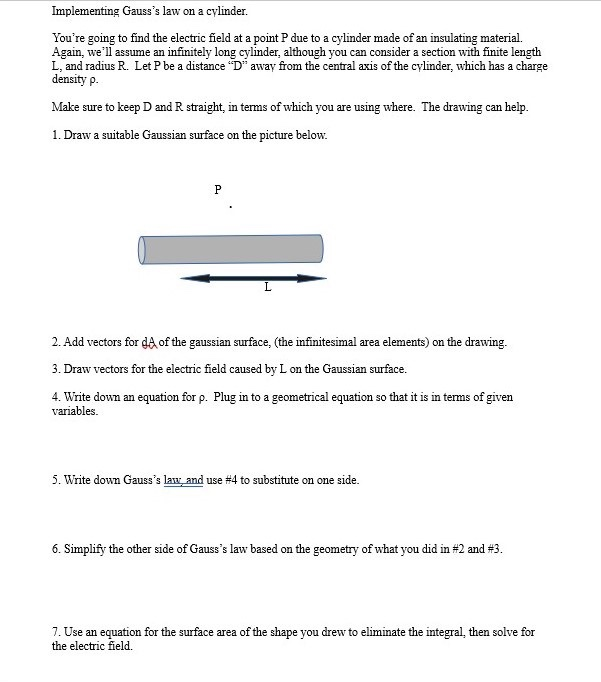Implementing Gauss's law on a cylinder. You're going to find the electric field at a point P due to a cylinder made of an insulating material. Again, we'll assume an infinitely long cylinder, although you can consider a section with finite length L, and radius R. Let P be a distance "D" away from the central axis of the cylinder, which has a charge density p. Make sure to keep D and R straight, in terms of which you are using where. The drawing can help. 1. Draw a suitable Gaussian surface on the picture below. P 2. Add vectors for då of the gaussian surface, (the infinitesimal area elements) on the drawing. 3. Draw vectors for the electric field caused by L on the Gaussian surface. 4. Write down an equation for p. Plug in to a geometrical equation so that it is in terms of given variables. 5. Write down Gauss's law, and use #4 to substitute on one side. 6. Simplify the other side of Gauss's law based on the geometry of what you did in #2 and # 3. 7. Use an equation for the surface area of the shape you drew to eliminate the integral, then solve for the electric field.
Implementing Gauss's law on a cylinder. You're going to find the electric field at a point P due to a cylinder made of an insulating material. Again, we'll assume an infinitely long cylinder, although you can consider a section with finite length L, and radius R. Let P be a distance "D" away from the central axis of the cylinder, which has a charge density p. Make sure to keep D and R straight, in terms of which you are using where. The drawing can help. 1. Draw a suitable Gaussian surface on the picture below. P 2. Add vectors for då of the gaussian surface, (the infinitesimal area elements) on the drawing. 3. Draw vectors for the electric field caused by L on the Gaussian surface. 4. Write down an equation for p. Plug in to a geometrical equation so that it is in terms of given variables. 5. Write down Gauss's law, and use #4 to substitute on one side. 6. Simplify the other side of Gauss's law based on the geometry of what you did in #2 and # 3. 7. Use an equation for the surface area of the shape you drew to eliminate the integral, then solve for the electric field.
Physics for Scientists and Engineers: Foundations and Connections
1st Edition
ISBN:9781133939146
Author:Katz, Debora M.
Publisher:Katz, Debora M.
Chapter25: Gauss’s Law
Section: Chapter Questions
Problem 68PQ: Examine the summary on page 780. Why are conductors and charged sources with linear symmetry,...
Related questions
Question

Transcribed Image Text:Implementing Gauss's law on a cylinder.
You're going to find the electric field at a point P due to a cylinder made of an insulating material.
Again, we'll assume an infinitely long cylinder, although you can consider a section with finite length
L, and radius R. Let P be a distance "D" away from the central axis of the cylinder, which has a charge
density p.
Make sure to keep D and R straight, in terms of which you are using where. The drawing can help.
1. Draw a suitable Gaussian surface on the picture below.
P
L
2. Add vectors for då of the gaussian surface, (the infinitesimal area elements) on the drawing.
3. Draw vectors for the electric field caused by L on the Gaussian surface.
4. Write down an equation for p. Plug in to a geometrical equation so that it is in terms of given
variables.
5. Write down Gauss's law, and use # 4 to substitute on one side.
6. Simplify the other side of Gauss's law based on the geometry of what you did in #2 and #3.
7. Use an equation for the surface area of the shape you drew to eliminate the integral, then solve for
the electric field.
Expert Solution
This question has been solved!
Explore an expertly crafted, step-by-step solution for a thorough understanding of key concepts.
This is a popular solution!
Trending now
This is a popular solution!
Step by step
Solved in 2 steps with 1 images

Follow-up Questions
Read through expert solutions to related follow-up questions below.
Follow-up Question
for step one can you provide the drawing of how you would do it on the original picture and for your Gaussian surface did you choose a square ?
Solution
Knowledge Booster
Learn more about
Need a deep-dive on the concept behind this application? Look no further. Learn more about this topic, physics and related others by exploring similar questions and additional content below.Recommended textbooks for you

Physics for Scientists and Engineers: Foundations…
Physics
ISBN:
9781133939146
Author:
Katz, Debora M.
Publisher:
Cengage Learning

Physics for Scientists and Engineers: Foundations…
Physics
ISBN:
9781133939146
Author:
Katz, Debora M.
Publisher:
Cengage Learning